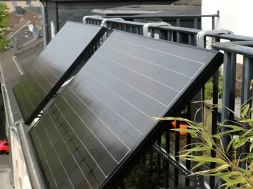
With growing emphasis on climate policy heading into the 2020 election season, ACORE has released a white paper assessing notable climate policy approaches for their impact on renewable energy growth and investment, including a federal high-penetration renewable energy standard or clean energy standard, a technology-neutral tax credit, and carbon pricing regimes.
 The new report, Advancing America’s Climate Leadership: Policy Options That Most Effectively Put Renewable Energy to Work, helps lay the groundwork for implementation as ACORE offers policy design recommendations and identifies complementary measures to ready the electric grid for the higher levels of renewable energy penetration necessary to achieve ambitious greenhouse gas (GHG) emissions reductions.
The new report, Advancing America’s Climate Leadership: Policy Options That Most Effectively Put Renewable Energy to Work, helps lay the groundwork for implementation as ACORE offers policy design recommendations and identifies complementary measures to ready the electric grid for the higher levels of renewable energy penetration necessary to achieve ambitious greenhouse gas (GHG) emissions reductions.
Here are some of the report’s key takeaways:
- A federal high-penetration renewable energy standard (RES) or clean energy standard (CES) would require a minimum percentage of renewable or zero-carbon energy in electricity supply companies’ electricity sales, generating capacity or electricity purchases. A federal high-penetration RES or CES represents a direct and reliable way to ensure scientifically driven emissions reductions in the electricity sector. The history of successful state renewable energy standards indicates that the long-term market certainty provided by a RES can catalyze renewable energy investment and deployment. An effective program should respect ambitious state programs already in place, and carefully incentivize progress in states with limited renewable energy resources or deployment.
- A technology-neutral tax credit for zero or low-carbon electricity generation would simplify the tax code and incentivize the market to produce cost-effective climate outcomes, rather than technology-specific inputs. This approach would lower the delivered cost of clean energy to consumers, which could be especially useful in states with higher initial RES compliance costs, and help attract capital to renewable energy investment after the currently scheduled phasedown of existing wind and solar tax credits. A technology-neutral tax credit could also address the continued need for long-term parity in the tax code with fossil fuel generation by displacing the range of permanent incentives for emitting resources which otherwise would work at cross-purposes with the policy goals of the new credit. The credit should be made transferable or refundable in order to enhance its efficiency and impact.
- Carbon pricing internalizes the costs of carbon pollution and sends a powerful market signal to drive low-and zero-carbon solutions across the economy. The economy-wide reach of carbon pricing is essential for avoiding carbon leakage and associated price distortions. It also addresses the reality that more than two-thirds of U.S. carbon pollution comes from outside the electricity sector. However, not all carbon pricing is created equal. If the goal of carbon pricing is to drive deployment of pollution-free renewable power to help meet mid-century climate goals, policymakers should take care to design a carbon pricing system that accomplishes that objective and avoids simply prompting near-term fuel-switching from coal to natural gas. In the absence of other complementary climate policies that mitigate such an outcome, there is a risk that the wrong price structure could incentivize investment in new natural gas infrastructure that could become the next generation of stranded assets as we approach more ambitious carbon reduction goals post-2030.
- Finally, we must modernize our antiquated electrical grid to better accommodate the growth of clean energy spurred by these climate policy options through improved transmission planning, enhanced transmission incentives, streamlined siting and permitting for renewable energy generation facilities, improved power markets, and increased measures to foster the growth of energy storage and advanced grid technologies.
This report, the second in ACORE’s series on climate policy, builds on last fall’s white paper with Wilson Sonsini Goodrich & Rosati entitled Enacting A Federal High-Penetration Renewable Energy Standard: Building on Proposals to Date and Addressing Important Additional Considerations. We invite policymakers, the media and all stakeholders to read the full Advancing America’s Climate Leadership white paper to learn more about how smart policy approaches can accelerate the transition to a renewable energy economy.
















